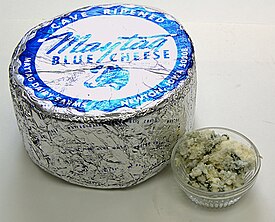
Dairy products or milk products, also known as lacticinia, are food products made from milk. The most common dairy animals are cow, water buffalo, nanny goat, and ewe. Dairy products include common grocery store food items in the Western world such as yogurt, cheese and butter. A facility that produces dairy products is known as a dairy. Dairy products are consumed worldwide to varying degrees. Some people avoid some or all dairy products either because of lactose intolerance, veganism, or other health reasons or beliefs.

Pizza cheese encompasses several varieties and types of cheeses and dairy products that are designed and manufactured for use specifically on pizza. These include processed and modified cheese such as mozzarella-like processed cheeses and mozzarella variants. The term can also refer to any type of cheese suitable for use on pizza. The most popular cheeses used in the preparation of pizza are mozzarella, provolone, cheddar and Parmesan. Emmental, Romano and ricotta are often used as toppings, and processed pizza cheeses manufactured specifically for pizza are mass-produced. Some mass-produced pizza cheeses are frozen after manufacturing and shipped frozen.
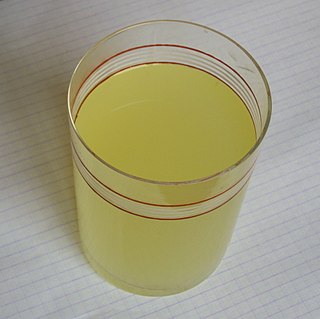
Whey is the liquid remaining after milk has been curdled and strained. It is a byproduct of the manufacturing of cheese or casein and has several commercial uses. Sweet whey is a byproduct resulting from the manufacture of rennet types of hard cheese, like cheddar or Swiss cheese. Acid whey is a byproduct brought out during the making of acid types of dairy products, such as strained yogurt.

Cottage cheese is a curdled milk product with a mild flavor and a creamy, non-homogeneous, soupy texture. It is made from skimmed milk, by draining curds — retaining some of the whey and keeping the curds loose. An important step in the manufacturing process distinguishing cottage cheese from other fresh cheeses is the adding of a "dressing" to the curd grains, usually cream, which is largely responsible for the taste of the product. Cottage cheese is not aged.
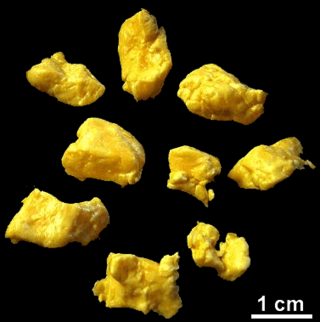
Curd is obtained by coagulating milk in a sequential process called curdling. It can be a final dairy product or the first stage in cheesemaking. The coagulation can be caused by adding rennet, a culture, or any edible acidic substance such as lemon juice or vinegar, and then allowing it to coagulate. The increased acidity causes the milk proteins (casein) to tangle into solid masses, or curds. Milk that has been left to sour will also naturally produce curds, and sour milk cheeses are produced this way. Producing cheese curds is one of the first steps in cheesemaking; the curds are pressed and drained to varying amounts for different styles of cheese and different secondary agents are introduced before the desired aging finishes the cheese. The remaining liquid, which contains only whey proteins, is the whey. In cow's milk, 90 percent of the proteins are caseins. Curds can be used in baking or may be consumed as a snack.
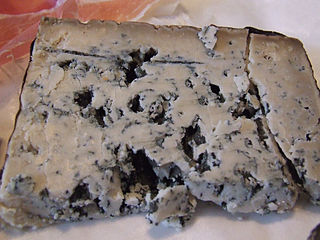
Cabrales is a blue cheese made in the artisan tradition by rural dairy farmers in Asturias, Spain. This cheese can be made from pure, unpasteurized cow’s milk or blended in the traditional manner with goat and/or sheep milk, which lends the cheese a stronger, spicier flavor.

Goat cheese, or chèvre, is cheese made from goat's milk. Goats were among the first animals to be domesticated for producing food. Goat cheese is made around the world with a variety of recipes, giving many different styles of cheese, from fresh and soft to aged and hard.

Leyden, from Dutch: Leidse kaas, is a semi-hard, cumin and caraway seed flavoured cheese made in the Netherlands from cow's milk. It is made both in factories and on farms, historically in the Leiden area.
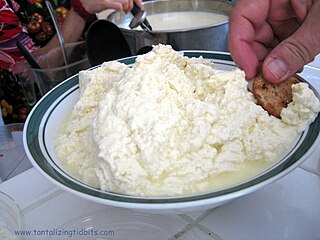
Ricotta is an Italian whey cheese made from sheep, cow, goat, or Italian water buffalo milk whey left over from the production of other cheeses. Like other whey cheeses, it is made by coagulating the proteins that remain after the casein has been used to make cheese, notably albumin and globulin.

Colby is a semi-hard orange cheese made from cow's milk. It is named after the city of Colby, Wisconsin, where it was first developed in 1885 and quickly became popular.

Cheesemaking is the craft of making cheese. The production of cheese, like many other food preservation processes, allows the nutritional and economic value of a food material, in this case milk, to be preserved in concentrated form. Cheesemaking allows the production of the cheese with diverse flavors and consistencies.

Blue cheese is semi-soft cheese with a sharp, salty flavor. It is made with cultures of the edible mold Penicillium, giving it spots or veins throughout the cheese in shades of blue or green. It carries a distinct smell, either from the mold or from various specially cultivated bacteria such as Brevibacterium linens, which also causes foot odor and other human body odors.

Acid-set or sour milk cheese is cheese that has been curdled (coagulated) by natural souring, often from lactic acid bacteria, or by the addition of acid. This type of cheese is technologically simple to produce.
The manufacture of Cheddar cheese includes the process of cheddaring, which makes this cheese unique. Cheddar cheese is named for the village of Cheddar in Somerset in South West England where it was originally manufactured. The manufacturing of this cheese has since spread around the world and thus the name has become generically known.
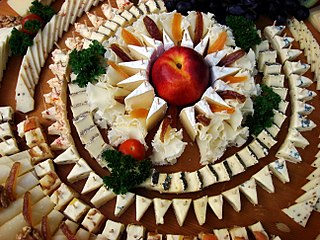
Cheese is a dairy product produced in wide ranges of flavors, textures, and forms by coagulation of the milk protein casein. It comprises proteins and fat from milk, usually the milk of cows, buffalo, goats, or sheep. During production, milk is usually acidified and the enzymes of either rennet or bacterial enzymes with similar activity are added to cause the casein to coagulate. The solid curds are then separated from the liquid whey and pressed into finished cheese. Some cheeses have aromatic molds on the rind, the outer layer, or throughout.

There are many different types of cheese. Cheeses can be grouped or classified according to criteria such as length of fermentation, texture, methods of production, fat content, animal milk, and country or region of origin. The method most commonly and traditionally used is based on moisture content, which is then further narrowed down by fat content and curing or ripening methods. The criteria may either be used singly or in combination, with no single method being universally used.
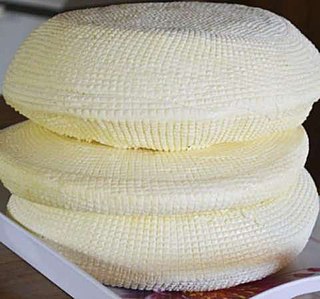
Paraguay cheese is a cows' milk cheese from Paraguay. It gives the Paraguayan cuisine a high value in calories and proteins, especially in the salted dishes recipes, very characteristic of the country and an important part of its culture.
The Caves of Faribault is an artisan cheese company headquartered in Faribault, Minnesota as a division of Swiss Valley Farms. Utilizing sandstone caves to age cheese, the company makes a variety of raw milk products, including several styles of blue cheese, Gouda, and cheddar.
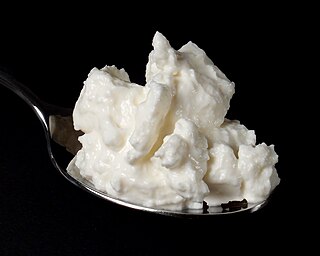
Quark or quarg is a type of fresh dairy product made from milk. The milk is soured, usually by adding lactic acid bacteria cultures, and strained once the desired curdling is achieved. It can be classified as fresh acid-set cheese. Traditional quark can be made without rennet, but in modern dairies small quantities of rennet are typically added. It is soft, white and unaged, and usually has no salt added. It is traditional in the cuisines of Baltic, Germanic and Slavic-speaking countries.

Sour cream or soured cream is a dairy product obtained by fermenting regular cream with certain kinds of lactic acid bacteria. The bacterial culture, which is introduced either deliberately or naturally, sours and thickens the cream. Its name comes from the production of lactic acid by bacterial fermentation, which is called souring. Crème fraîche is one type of sour cream with a high fat content and less sour taste.
